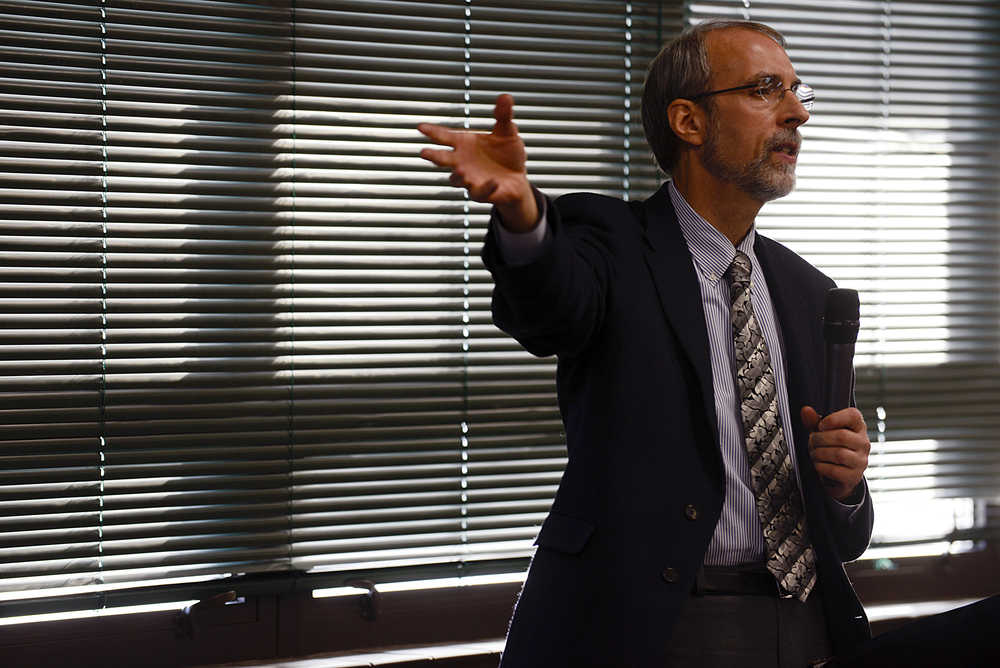The first time the Federal Energy Regulatory Commission published an environmental impact statement under its current process, the proposed project was based in Nikiski — now, federal regulators have returned, nearly 40 years later, to evaluate the latest mega-project in Alaska’s pipeline history.
Members of the business community gathered for Tuesday’s joint Kenai and Soldotna Chambers of Commerce luncheon to hear from Larry Persily, Federal Coordinator for Alaska Gas Line Projects, as he presented the scope of the research that would need to be done for the Alaska LNG project to move forward.
But first, he told the audience about a proposal that would have taken Cook Inlet gas and shipped it to California.
It would have cost more than $1 billion in the 1970s and got into a phase of the project planning that required an environmental assessment before it was ultimately rejected, according to an Alaska Natural Gas Transportation Projects summary.
Persily, who brought several dozen reports for audience members to peruse, said the most important thing Cook Inlet residents could do was educate themselves on the potential impacts the LNG project could have on their communities.
“Our job is to coordinate, as best we can, all of the federal agencies that are going to be involved in this project so they don’t screw it up,” Persily said. “That’s pretty much the way to put it. If it all goes well and the project succeeds, you should thank your local elected officials … if it collapses and goes bad and nothing happens — just blame the feds because we do that in Alaska very well anyhow.”
Developers in Alaska need federal authorization to move gas from Prudhoe Bay to Nikiski, a project that involves building and operating the LNG plant, the more than 800 mile pipeline, a gas treatment plant at the North Slope and several compressor stations along the route.
“There will be a comprehensive federal environmental impact statement that (the Federal Energy Regulatory Commission) will do and that other agencies will rely on for their decisions,” Persily said.
The companies have initiated a pre-filing with FERC, a period that will last a few years, and part of that time includes finding out which data federal agencies need and when those agencies will need it.
FERC agents will travel around the state for the next few weeks and in the coming months, to hear what issues Alaskans want to see addressed in the agency’s impact statement.
“Right now Alaska LNG is telling the federal government that they expect to submit their completed application in 2016,” Persily said.
That application must have at 13 resource reports which will measure impacts and define project scope. The reports include:
■ Project description
■ Water use, quality
■ Fish, wildlife and vegetation
■ Cultural resources
■ Socioeconomics
■ Geological resources
■ Soils
■ Land use, recreation and aesthetics
■ Air and Noise Quality
■ Alternatives
■ Reliability and safety
■ PCB contamination
■ Engineering and Design
“The one I think is going to be the most important to the community is that fifth one, socioeconomics,” Persily said. “That’s ‘what’s it going to do to your life here?’”
Persily, who had many in the audience laughing for most of his presentation, said the environmental impact statement would be long and difficult to read.
“I’ve got to admit, until I got this job, I never wanted to read an environmental impact statement. They’re just dreadful,” he said. “It’s something the community is going to have to pay attention to.”
Persily said community members would be responsible for holding the project accountable.
“FERC can order mitigation as part of their approval for the project, they can say, ‘OK, you can go ahead and build and operate it, but here’s the list of things you’ve got to do so you don’t screw up the town, or you don’t mess up the waterway, or you don’t ruin the beach.’ Federal agents will certainly read it and make comments but, we don’t live here. So, on these issues, it’s really up to you to watch out for yourselves.”
Rep. Mike Chenault, R-Nikiski, was in the audience and said he could see why some were impatient with the process.
“You know, people say, why don’t we just build it? Let’s quit studying and, that’s just the process that we have. I can’t tell the EPA to go take a hike and so permitting the process is what it is,” Chenault said. “We’re going to go through the process and, what I hope at the end of the day is that we have enough information to make an informed decision.”
Chenault said he supported the proposed project.
“What I’m hoping is that we’re able to get through that process, the contracts, forms to be in place, to allow folks to make a 30-year commitment to a $60 billion project and we get moving forward at that point,” Chenault said. “It will change Alaska forever and I believe that’s in a good way.”
Rashah McChesney can be reached at rashah.mcchesney@peninsulaclarion.com.

